
Journal of Health Sciences and Medicine
Yazarlar: ["Meliha Melin UYGUR"]
Konular:-
DOI:10.32322/jhsm.1126149
Anahtar Kelimeler:Body mass index,Waist to height ratio,Obesity,Cardiovascular risk
Özet: Introduction: A waist to height ratio (WHtR) greater than 0.5 may be a global screening tool for cardiovascular disease (CVD) and diabetes. However, it is unclear whether WHtR could be used instead of BMI. This study aimed to evaluate the role of BMI regarding CVD and diabetes in a subset of Turkish adults with WHtR greater than 0.5. Material and Method: The cross-sectional study involved 118 participants with WHtR>0.5, 18 years and older who applied to the endocrinology and metabolism disease outpatient clinic between September 2019 and February 2020. WHtR and BMI were calculated. Results: The prevalence of hypertension and hyperlipidemia increased with BMI. WHtR was correlated with FBG. BMI was significantly associated with TG, HDL-c, SBP, and DBP in linear regression analysis, but not with FBG. On the other hand, there was a significant association between WHtR and FBG. Conclusion: This study confirmed that the simple value of ‘0.5’ for WHtR was associated with diabetes risk. The cut-off value of 35 for BMI was effective categorizing participants with high blood pressure and lipid levels in paticipants with high WHtR. Further population-based studies in Turkish adults are needed to evaluate whether WHtR could be used independent from BMI as an early warning of cardiovascular risks for preventive interventions.